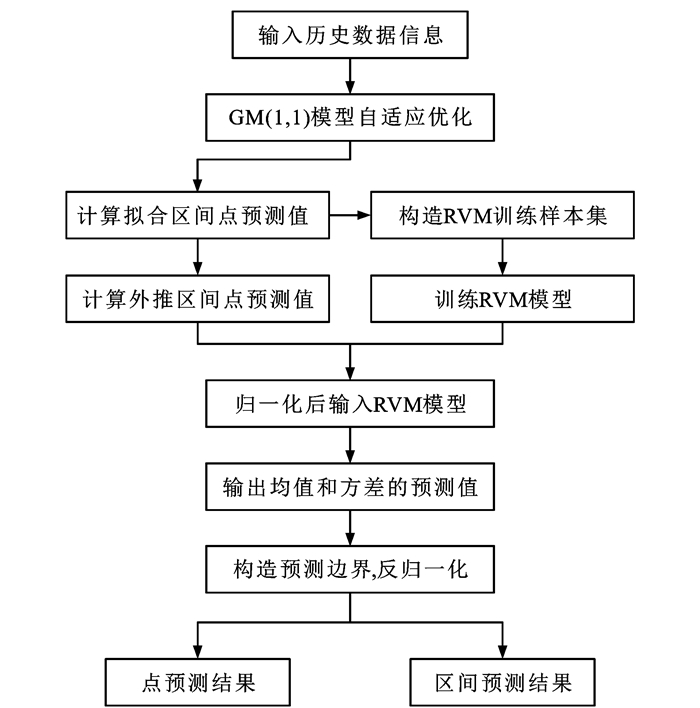Interval prediction of track irregularity based on GM(1, 1) model and relevance vector machine
-
摘要: 为开展以预防修为主的养护维修作业,联合GM(1, 1)灰色模型与相关向量机(RVM)算法,提出一种预测轨道不平顺演化区间的GM(1, 1)-RVM组合模型;结合轨道质量指数(TQI)的振荡演变特性,通过二次-对数复合函数平滑优化和序列权重优化改进了GM(1, 1)模型,通过粒子群优化(PSO)算法对待优化参数进行搜索确定,并在此基础上计算点的预测值;构造以点预测值为输入,以TQI实测值为输出的样本特征映射模式,引入5折交叉验证环节优化与训练了RVM模型的组合核函数;通过GM(1, 1)模型与RVM模型间的输入-输出衔接机制集成了组合预测模型,并以某有砟线路中的2个区段为实例检验了轨道不平顺区间的预测效果。研究结果表明:与既有预测模型相比,改进GM(1, 1)-RVM组合模型可得到预测区间的均值和方差,从而将预测结果从单点数值扩充到预测区间;2个区段实例在外推区间上的点预测结果与TQI真实值相比,平均百分比误差分别为1.53%和4.67%,较支持向量回归(SVR)模型分别降低了0.58%和0.61%,较GM(1, 1)-反向传播神经网络(BPNN)模型分别降低了0.15%和1.87%;改进GM(1, 1)-RVM组合模型在90%、95%和99%三种置信度下的最大平均预测区间宽度分别为0.324 5、0.387 9和0.510 5 mm,最低预测区间覆盖率分别为91.67%、95.83%和95.83%,预测区间基本涵盖了外推区间内的TQI演化数据。可见,利用预测的均值和方差构造区间边界可有效把控轨道不平顺演变过程中的随机波动,为轨道不平顺预测提供了一种新思路。Abstract: The GM(1, 1) grey model and relevance vector machine (RVM) algorithm were integrated to propose a GM(1, 1)-RVM combination model for the interval prediction of track irregularities to carry out the preventive maintenance work. Considering the oscillation characteristics of the track quality index (TQI), the GM(1, 1) model was improved by smooth optimization of the quadratic-logarithmic composite function and sequence weight optimization. The parameters to be optimized were searched and determined by the particle swarm optimization (PSO) algorithm, and then the predicted point values were calculated. The mapping mode of sample features with the predicted point value as input and the true TQI as output was constructed, and the 5-fold cross-validation was introduced to optimize and train the combined kernel function of the RVM model. The combination prediction model was integrated by the input-output alignment mechanism between the GM(1, 1) model and the RVM model, and the prediction effect of the track irregularity interval was tested by taking two sections of a ballasted railway line as examples. Research results show that compared with the existing prediction models, the mean and variance of the predicted interval can be calculated by the improved GM(1, 1)-RVM combination model to expand the prediction results from single point values to prediction intervals. Compared with the true TQIs, the mean percentage errors of the predicted point results obtained by the improved GM(1, 1)-RVM combination model on the extrapolation range at the two sections are 1.53% and 4.67%, respectively, and they are 0.58% and 0.61% lower than the support vector regression (SVR) model, respectively, and 0.15% and 1.87% lower than the GM(1, 1)-back propagation neural network (BPNN) model, respectively. Under the confidence levels of 90%, 95%, and 99%, the maximum mean prediction interval widths obtained by the improved GM(1, 1)-RVM combination model are 0.324 5, 0.387 9, and 0.510 5 mm, respectively, and the minimum prediction interval coverage rates are 91.67%, 95.83%, and 95.83%, respectively. The prediction interval can cover most of the TQI evolution data on the extrapolation interval. Thus, the random fluctuation in the track irregularity evolution can be controlled by employing the predicted mean and variance to construct the interval boundary, which provides a new idea for the track irregularity prediction. 3 tabs, 5 figs, 30 refs.
-
表 1 TQI检测数据
Table 1. Detection data of TQI
动检日期 相对时间/d 实测值/mm 动检日期 相对时间/d 实测值/mm 动检日期 相对时间/d 实测值/mm TQI1 TQI2 TQI1 TQI2 TQI1 TQI2 2021-01-07 0 2.65 2.47 2021-05-07 120 2.96 2.56 2021-09-07 243 3.06 3.08 2021-01-21 14 2.55 2.25 2021-05-20 133 2.91 2.54 2021-09-24 260 3.04 3.07 2021-02-01 25 2.63 2.31 2021-06-07 151 2.94 2.54 2021-10-09 275 3.08 3.33 2021-02-21 45 2.55 2.17 2021-06-20 164 2.74 2.5 2021-10-23 289 3.13 3.27 2021-03-01 53 2.37 2.59 2021-07-05 179 2.74 2.81 2021-11-08 305 3.17 3.37 2021-03-15 67 2.51 2.44 2021-07-21 195 2.83 2.87 2021-11-15 312 3.04 3.16 2021-04-06 89 2.84 2.73 2021-08-03 208 2.74 3.13 2021-11-22 319 3.12 3.64 2021-04-18 101 2.99 2.65 2021-08-15 220 3.02 3.15 2021-12-08 335 3.06 3.47 表 2 K210+800~K211+000区段预测精度
Table 2. Prediction accuracies of K210+800-K211+000 section
-
[1] 李再帏, 雷晓燕, 高亮. 轨道短波不平顺数值模拟新方法[J]. 交通运输工程学报, 2016, 16(1): 37-45. doi: 10.19818/j.cnki.1671-1637.2016.01.005LI Zai-wei, LEI Xiao-yan, GAO Liang. New numerical simulation method of shortwave track irregularity[J]. Journal of Traffic and Transportation Engineering, 2016, 16(1): 37-45. (in Chinese) doi: 10.19818/j.cnki.1671-1637.2016.01.005 [2] 肖乾, 王丹红, 陈道云, 等. 高速列车轮轨激励作用机理及其影响综述[J]. 交通运输工程学报, 2021, 21(3): 93-109. doi: 10.19818/j.cnki.1671-1637.2021.03.005XIAO Qian, WANG Dan-hong, CHEN Dao-yun, et al. Review on mechanism and influence of wheel-rail excitation of high-speed train[J]. Journal of Traffic and Transportation Engineering, 2021, 21(3): 93-109. (in Chinese) doi: 10.19818/j.cnki.1671-1637.2021.03.005 [3] GONZALO A P, HORRIDGE R, STEELE H, et al. Review of data analytics for condition monitoring of railway track geometry[J]. IEEE Transactions on Intelligent Transportation Systems, 2022, 23(12): 22737-22754. doi: 10.1109/TITS.2022.3214121 [4] LASISI A, ATTOH-OKINE N. An unsupervised learning framework for track quality index and safety[J]. Transportation Infrastructure Geotechnology, 2020, 7(1): 1-12. doi: 10.1007/s40515-019-00087-6 [5] ANDRADE A R, TEIXEIRA P F. Uncertainty in rail-track geometry degradation: Lisbon-Oporto Line case study[J]. Journal of Transportation Engineering, 2011, 137(3): 193-200. doi: 10.1061/(ASCE)TE.1943-5436.0000206 [6] CAETANO L F, TEIXEIRA P F. Availability approach to optimizing railway track renewal operations[J]. Journal of Transportation Engineering, 2013, 139(9): 941-948. doi: 10.1061/(ASCE)TE.1943-5436.0000575 [7] KHOUZANI A H E, GOLROO A, BAGHERI M. Railway maintenance management using a stochastic geometrical degradation model[J]. Journal of Transportation Engineering, Part A: Systems, 2017, 143(1): 4016002. doi: 10.1061/JTEPBS.0000002 [8] FAMUREWA S M, JUNTTI U, NISSEN A, et al. Augmented utilisation of possession time: analysis for track geometry maintenance[J]. Proceedings of the Institution of Mechanical Engineers, Part F: Journal of Rail and Rapid Transit, 2016, 230(4): 1118-1130. doi: 10.1177/0954409715583890 [9] LIU Reng-kui, XU Peng, WANG Fu-tian. Research on a short-range prediction model for track irregularity over small track lengths[J]. Journal of Transportation Engineering, 2010, 136(12): 1085-1091. doi: 10.1061/(ASCE)TE.1943-5436.0000192 [10] XU P, SUN Q, LIU R, et al. A short-range prediction model for track quality index[J]. Proceedings of the Institution of Mechanical Engineers, Part F: Journal of Rail and Rapid Transit, 2011, 225(3): 277-285. doi: 10.1177/2041301710392477 [11] 常艳艳, 刘仍奎, 王福田, 等. 兰新线铁路轨道几何状态劣化短期预测模型研究[J]. 铁道学报, 2020, 42(11): 124-129.CHANG Yan-yan, LIU Reng-kui, WANG Fu-tian, et al. Short-term prediction model for track geometry degradation on Lanzhou-Xinjiang Railway[J]. Journal of the China Railway Society, 2020, 42(11): 124-129. (in Chinese) [12] LASISI A, ATTOH-OKINE N. Principal components analysis and track quality index: a machine learning approach[J]. Transportation Research Part C: Emerging Technologies, 2018, 91: 230-248. doi: 10.1016/j.trc.2018.04.001 [13] SRESAKOOLCHAI J, KAEWUNRUEN S. Railway defect detection based on track geometry using supervised and unsupervised machine learning[J]. Structural Health Monitoring, 2022, 21(4): 1757-1767. doi: 10.1177/14759217211044492 [14] KHAJEHEI H, AHMADI A, SOLEIMANMEIGOUNI I, et al. Prediction of track geometry degradation using artificial neural network: a case study[J]. International Journal of Rail Transportation, 2022, 10(1): 24-43. doi: 10.1080/23248378.2021.1875065 [15] GULER H. Prediction of railway track geometry deterioration using artificial neural networks: a case study for Turkish state railways[J]. Structure and Infrastructure Engineering, 2014, 10(5): 614-626. doi: 10.1080/15732479.2012.757791 [16] LEE J S, HWANG S H, CHOI I Y, et al. Prediction of track deterioration using maintenance data and machine learning schemes[J]. Journal of Transportation Engineering, Part A: Systems, 2018, 144(9): 04018045. doi: 10.1061/JTEPBS.0000173 [17] 彭丽宇, 张进川, 苟娟琼, 等. 基于BP神经网络的铁路轨道几何不平顺预测方法[J]. 铁道学报, 2018, 40(9): 154-158.PENG Li-yu, ZHANG Jin-chuan, GOU Juan-qiong, et al. Prediction method of railway track geometric irregularity based on BP neural network[J]. Journal of the China Railway Society, 2018, 40(9): 154-158. (in Chinese) [18] 于瑶, 刘仍奎, 王福田. 基于支持向量机的轨道不平顺预测研究[J]. 铁道科学与工程学报, 2018, 15(7): 1671-1677.YU Yao, LIU Reng-kui, WANG Fu-tian. Prediction for track irregularity based on support vector machine[J]. Journal of Railway Science and Engineering, 2018, 15(7): 1671-1677. (in Chinese) [19] 韩晋, 杨岳, 陈峰, 等. 基于非等时距加权灰色模型与神经网络的轨道不平顺预测[J]. 铁道学报, 2014, 36(1): 81-87.HAN Jin, YANG Yue, CHEN Feng, et al. Prediction of track irregularity based on non-equal interval weighted grey model and neural network[J]. Journal of the China Railway Society, 2014, 36(1): 81-87. (in Chinese) [20] 马子骥, 郭帅锋, 李元良. 基于改进非等间距灰色模型和PSVM的轨道质量指数预测[J]. 铁道学报, 2018, 40(6): 154-160.MA Zi-ji, GUO Shuai-feng, LI Yuan-liang. Forecasting of track irregularity based on improved non-equal interval grey model and PSVM[J]. Journal of the China Railway Society, 2018, 40(6): 154-160. (in Chinese) [21] TIPPING M E. Sparse Bayesian learning and the relevance vector machine[J]. Journal of Machine Learning Research, 2001, 1(3): 211-244. [22] 明祖涛, 刘军, 夏力, 等. 改进的灰色模型在高铁沉降预测中的应用[J]. 测绘科学, 2015, 40(4): 137-140.MING Zu-tao, LIU Jun, XIA Li, et al. Study of the implementation of improved grey model in high-speed railway settlement prediction[J]. Science of Surveying and Mapping, 2015, 40(4): 137-140. (in Chinese) [23] NABAEI A, HAMIAN M, PARSAEI M R, et al. Topologies and performance of intelligent algorithms: a comprehensive review[J]. Artificial Intelligence Review, 2018, 49(1): 79-103. doi: 10.1007/s10462-016-9517-3 [24] 杨维, 李歧强. 粒子群优化算法综述[J]. 中国工程科学, 2004, 6(5): 87-94.YANG Wei, LI Qi-qiang. Survey on particle swarm optimization algorithm[J]. Engineering Science, 2004, 6(5): 87-94. (in Chinese) [25] 王春雷, 赵琦, 秦孝丽, 等. 基于改进相关向量机的锂电池寿命预测方法[J]. 北京航空航天大学学报, 2018, 44(9): 1998-2003.WANG Chun-lei, ZHAO Qi, QIN Xiao-li, et al. Life prediction method of lithium battery based on improved relevance vector machine[J]. Journal of Beijing University of Aeronautics and Astronautics, 2018, 44(9): 1998-2003. (in Chinese) [26] 雷亚国, 陈吴, 李乃鹏, 等. 自适应多核组合相关向量机预测方法及其在机械设备剩余寿命预测中的应用[J]. 机械工程学报, 2016, 52(1): 87-93.LEI Ya-guo, CHEN Wu, LI Nai-peng, et al. A relevance vector machine prediction method based on adaptive multi-kernel combination and its application to remaining useful life prediction of machinery[J]. Journal of Mechanical Engineering, 2016, 52(1): 87-93. (in Chinese) [27] FALAMARZI A, MORIDPOUR S, NAZEM M, et al. Prediction of tram track gauge deviation using artificial neural network and support vector regression[J]. Australian Journal of Civil Engineering, 2019, 17(1): 63-71. doi: 10.1080/14488353.2019.1616357 [28] 李麟玮, 吴益平, 苗发盛, 等. 基于不同Bootstrap方法和KELM-BPNN模型的滑坡位移区间预测[J]. 岩石力学与工程学报, 2019, 38(5): 912-926.LI Lin-wei, WU Yi-ping, MIAO Fa-sheng, et al. Landslide displacement interval prediction based on different Bootstrap methods and KELM-BPNN model[J]. Chinese Journal of Rock Mechanics and Engineering, 2019, 38(5): 912-926. (in Chinese) [29] 惠阳, 王永岗, 彭辉, 等. 基于优化PSO-BP算法的耦合时空特征下地铁客流预测[J]. 交通运输工程学报, 2021, 21(4): 210-222. doi: 10.19818/j.cnki.1671-1637.2021.04.016HUI Yang, WANG Yong-gang, PENG Hui, et al. Subway passenger flow prediction based on optimized PSO-BP algorithm with coupled spatial-temporal characteristics[J]. Journal of Traffic and Transportation Engineering, 2021, 21(4): 210-222. (in Chinese) doi: 10.19818/j.cnki.1671-1637.2021.04.016 [30] 刘刚, 孙佳琦, 董伟星. 改进粒子群优化算法在建筑能耗优化中的参数设置[J]. 天津大学学报(自然科学与工程技术版), 2021, 54(1): 82-90.LIU Gang, SUN Jia-qi, DONG Wei-xing. Parameter settings of improved particle swarm optimization algorithm in building energy consumption optimization[J]. Journal of Tianjin University (Science and Technology), 2021, 54(1): 82-90. (in Chinese) -





 下载:
下载:






